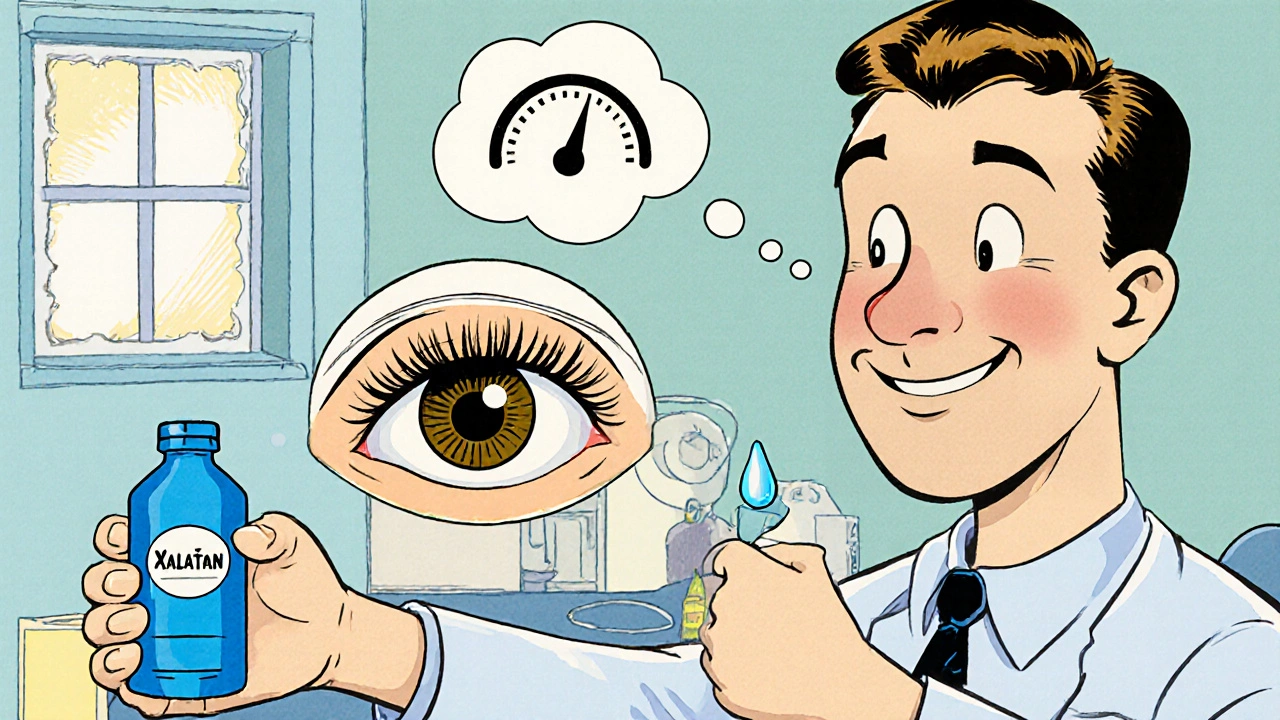Xalatan vs Alternatives: Detailed Eye‑Drop Comparison
 Oct, 25 2025
Oct, 25 2025
Glaucoma Eye Drop Comparison Tool
Compare Your Eye Drop Options
Based on your priorities (cost, side effects, efficacy), we'll show which glaucoma eye drops are best suited for you.
Results
| Drug | Active Ingredient | Cost (US$) | Preservative-Free | Efficacy (IOP Reduction) | Key Side Effects |
|---|---|---|---|---|---|
| Xalatan | latanoprost | $120 | No | 25-30% | Eyelash growth, iris darkening |
| Lumigan | bimatoprost | $150 | No | 26-31% | Hyperemia, eyelash growth |
| Travatan Z-P | travoprost | $130 | Yes | 24-29% | Dryness, hyperemia |
| Taflotan | tafluprost | $110 | No | 23-28% | Less iris darkening |
| Rescula | unoprostone | $100 | No | 18-25% | Mild irritation |
When doctors treat open‑angle glaucoma, they often start with a prostaglandin analog eye drop. Xalatan is the brand name most patients hear about first, but a growing list of alternatives can be just as effective - sometimes with a better side‑effect profile or lower price.
What is Xalatan?
Xalatan contains the active ingredient latanoprost, a synthetic analogue of prostaglandin F2α. It works by increasing the outflow of aqueous humor, the fluid inside the eye, which reduces intraocular pressure (IOP). Lower IOP slows the damage to the optic nerve and helps preserve vision.
How Xalatan Performs in Real‑World Use
Clinical trials show that a single nightly drop of Xalatan can cut IOP by 25‑30% on average. Real‑world studies from the United States and Europe report similar reductions, with most patients reaching target pressures within two weeks. The drug is usually well tolerated, but the most common side effect is mild eyelash growth, known as hypertrichosis.
Why Look at Alternatives?
Even though Xalatan is effective, several factors push doctors and patients to consider other options:
- Cost - brand‑name drops can be pricey without insurance.
- Preservative sensitivity - many users develop irritation from the benzalkonium chloride (BAK) preservative.
- Specific side‑effects - some patients experience darkening of the iris or conjunctival hyperemia.
- Formulary restrictions - certain health plans favor generic or preservative‑free alternatives.
Top Prostglandin Analogs on the Market
Below is a quick snapshot of the most widely prescribed alternatives to Xalatan. Each belongs to the same drug class but differs in formulation, cost, and side‑effect nuances.
- bimatoprost (brand name Lumigan) - a prostamide that can lower IOP slightly more than latanoprost for some patients.
- travoprost (brand name Travatan Z) - offers a preservative‑free formulation (Travatan Z‑P) for sensitive eyes.
- tafluprost (brand name Taflotan) - approved in many European countries and often praised for modest iris‑darkening.
- unoprostone (brand name Rescula) - a weaker prostaglandin analogue that may be chosen for patients with milder pressure elevations.
Side‑Effect Profile Comparison
All prostaglandin analogs share a core set of side effects, but the frequency and severity vary. The table below highlights the most clinically relevant differences.
| Drug | Active ingredient | Typical cost (US$ per month) | Preservative‑free options | Most common side effects |
|---|---|---|---|---|
| Xalatan | latanoprost | ≈ $120 (brand) | No | Eyelash growth, iris darkening, mild irritation |
| Lumigan | bimatoprost | ≈ $150 (brand) | No | Conjunctival hyperemia, eyelash growth, darkening |
| Travatan Z‑P | travoprost | ≈ $130 (brand) | Yes (P‑free) | Dryness, hyperemia, occasional stinging |
| Taflotan | tafluprost | ≈ $110 (generic in EU) | No | Less iris darkening, occasional eye pain |
| Rescula | unoprostone | ≈ $100 (generic) | No | Less potent IOP reduction, mild irritation |

Decision Factors for Patients and Providers
When choosing a glaucoma drop, consider these practical points:
- Efficacy: All listed drugs lower IOP by roughly 20‑30%, but bimatoprost may edge out latanoprost by a percent or two in high‑risk patients.
- Cost & insurance coverage: Generic latanoprost and tafluprost often provide the best price‑performance ratio.
- Preservative sensitivity: If a patient reports burning or redness, a preservative‑free travoprost formulation may be the better pick.
- Cosmetic side effects: Those who dislike darker iris or longer lashes might prefer unoprostone, accepting a modest IOP drop.
- Dosing convenience: All are once‑daily, usually at night, making adherence easier.
Putting It All Together: Choosing the Right Eye Drop
Start with the clinical target: get IOP below the level that threatens optic‑nerve health. If Xalatan achieves that without bothersome side effects, it remains a solid first‑line choice. If cost or irritation becomes an issue, switch to a preservative‑free travoprost or a generic latanoprost formulation. For patients who need an extra‑strong pressure drop, bimatoprost can be tried under close monitoring.
Always involve the patient in the conversation. Explain the trade‑offs - a slightly higher price may buy a preservative‑free solution, while a modest increase in eyelash length could be an acceptable cosmetic bonus.
Frequently Asked Questions
Can I use Xalatan and another prostaglandin drop together?
No. Combining two prostaglandin analogs offers no added benefit and raises the risk of side effects. Instead, doctors may pair a prostaglandin with a different class, such beta‑blocker or carbonic anhydrase inhibitor.
Is preservative‑free travoprost as effective as Xalatan?
Yes. Clinical data show preservative‑free travoprost lowers IOP by the same amount as latanoprost. The main advantage is reduced ocular surface irritation for sensitive patients.
How long does it take to see IOP reduction after starting Xalatan?
Most patients achieve their target pressure within 1‑2 weeks, with the maximal effect reached around the 4‑week mark.
Are there any drug interactions with Xalatan?
Topically applied prostaglandin analogs have minimal systemic absorption, so drug‑drug interactions are rare. However, caution is advised when using other ocular medications that may affect corneal health.
Can children use Xalatan?
Xalatan is approved for adults. For pediatric glaucoma, physicians often choose other agents that have specific pediatric safety data.

Lisa Woodcock
October 25, 2025 AT 13:20I appreciate how the article lays out the cost and preservative factors side by side.
For many of my relatives living on a fixed income, the price difference between generic latanoprost and brand‑name Xalatan is a real concern.
Also, I've seen patients develop irritation from BAK, and switching to a preservative‑free travoprost made a noticeable improvement.
It's helpful to have the table handy when talking to the eye doctor about options.
Ultimately, a collaborative decision keeps everyone on board.
Sarah Keller
October 25, 2025 AT 13:41The notion that Xalatan is the default choice betrays a lazy adherence to pharma marketing.
In reality the prostaglandin class is a toolbox, not a monolith.
When a patient can’t tolerate benzalkonium chloride you must pivot to a preservative‑free formulation without hesitation.
Travoprost’s PF version delivers identical IOP reduction while sparing the ocular surface, which is a fact backed by multiple meta‑analyses.
If cost is the primary barrier, generic latanoprost is a viable alternative that shaves off 30‑40 % of the retail price.
Yet many clinicians overlook bimatoprost’s modest edge in pressure‑lowering for high‑risk eyes, clinging to brand loyalty.
This stubbornness can cost patients vision, because every mmHg matters in advanced glaucoma.
Moreover, the cosmetic side‑effects such as eyelash growth are seldom a deal‑breaker; many patients actually welcome them.
Conversely, iris hyperpigmentation is irreversible and should be disclosed upfront.
Insurance formularies that force a switch to a cheaper drug often ignore individual tolerability, leading to non‑adherence.
Non‑adherence is the silent killer behind uncontrolled IOP, not the drug itself.
Therefore a personalized algorithm that weighs efficacy, cost, preservative sensitivity, and cosmetic concerns is mandatory.
Providers should discuss these variables openly rather than defaulting to the “Xalatan first” mantra.
In the end, the goal is to keep the optic nerve safe, not to sell the most popular drop.
So question the status quo, demand options, and match the therapy to the patient’s unique profile.
Veronica Appleton
October 25, 2025 AT 14:06Xalatan works well for most people but it isn’t the only game in town.
If you have BAK sensitivity look at preservative‑free travoprost or generic latanoprost.
Talk to your doc about cost options.
Zaria Williams
October 25, 2025 AT 14:28i cant stress enough how annoyin it is when your eyes feel gritty after a drop.
bimatoprost can be a bit harsher on the surface for some folks.
also the darkening of the iris might not be everyone's vibe.
just keep an eye on any redness and let your doc know.
Charlie Stillwell
October 25, 2025 AT 14:40TL;DR: Xalatan is cost‑inefficient 🙄
Ken Dany Poquiz Bocanegra
October 25, 2025 AT 15:13The choice really comes down to individual tolerance and insurance coverage.
All prostaglandin analogs lower IOP similarly, so side‑effects become the differentiator.
A brief trial of a preservative‑free option is often worthwhile.
Tamara Schäfer
October 25, 2025 AT 15:46I totally agree with Ken his point about trying a preservative free version first.
In my experience the dry feeling after Xalatan can be quite uncomfortable.
I switched to travoprost‑p and the irritation disappeared almost overnight.
It’s also not much more expensive in most pharmacies.
Just remember to give it a couple of weeks to see full effect.
Tamara Tioran-Harrison
October 25, 2025 AT 16:36Ah, the illustrious Xalatan, champion of the ophthalmic realm-how magnanimously it graces our patients with elongated lashes.
One might presume such a marvel would be devoid of any drawbacks, yet cost and irritation persist, quite tragically.
Nevertheless, I shall bestow upon you my most profound recommendation: consider alternatives before succumbing to brand worship.
:)
kevin burton
October 25, 2025 AT 17:10I concur with the sentiment expressed above.
Preservative‑free travoprost offers comparable efficacy with reduced ocular surface inflammation.
For patients concerned about cost, generic latanoprost remains a reliable first‑line option.
Lennox Anoff
October 25, 2025 AT 18:00In the grand theatre of glaucoma management, Xalatan often steals the limelight, but the understudies deserve applause.
One cannot ignore the subtle nuances of iris pigmentation that betray the unwary.
Moreover, the financial curtain call can be abrupt for those without premium coverage.
Let us, therefore, script a more equitable narrative where efficacy and affordability share the stage.
Jennifer Stubbs
October 25, 2025 AT 18:33The data presented aligns with the known efficacy range of 20‑30 % IOP reduction across prostaglandins.
However, the table omits real‑world adherence statistics, which are pivotal for outcome prediction.
Including patient‑reported comfort scores would strengthen the comparison.
Abhinav B.
October 25, 2025 AT 19:56Namaste! From an Indian perspective, we often see patients who cannot afford the brand names and rely on generics.
Latanoprost is widely available here and works well if the bottle isn’t contaminated.
Preservative‑free options are limited but gaining traction in metro cities.
I encourage doctors to discuss these choices openly with their patients.
Let’s make eye care accessible for everyone.
Abby W
October 25, 2025 AT 20:46Great insights 🙌! I’ll definitely bring this up at my next appointment.